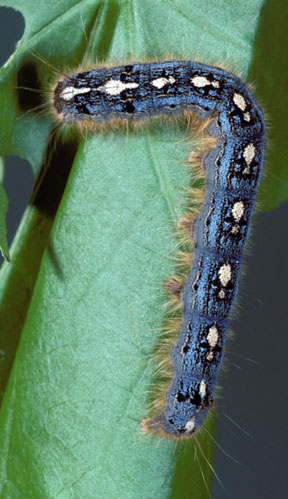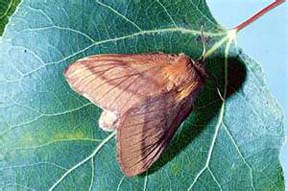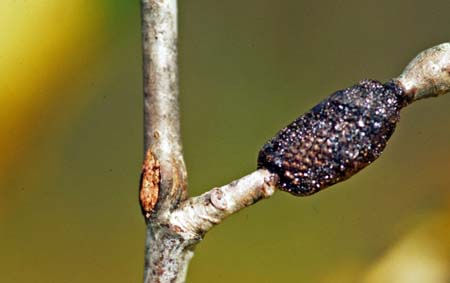Forest tent caterpillars can cause significant defoliation on landscape trees
Although forest tent caterpillars can cause defoliation of numerous landscape trees, control measures are rarely needed by homeowners.
The forest tent caterpillar, Malacosoma disstria, is an infrequent but important defoliator of many hardwood tree species. Population outbreaks typically last for two to three years before subsiding due to natural causes such as starvation, disease and natural enemies. The period between outbreaks is typically very long, often seven or more years and sometimes as long as 20 years.

Photo 1. Forest tent caterpillar.
Photo credit: Gerald J. Lenhard, Louiana State University, Bugwood.org
During outbreak years the tree defoliation by the caterpillars appears to be devastating, but healthy trees can withstand defoliation and put out a second flush of leaves after the feeding ends in June. The trees may not look real good for the rest of the year; their growth will be reduced, but they can overcome this. In fact, any old tree likely has done so several times in the past. Weak trees that are already suffering from old age, disease, injuries from construction or road work are naturally at risk for more severe impacts, and defoliation by forest tent caterpillars might be the factor that hastens their final decline. The death of some trees in a forest is a very natural process that occurs each year, and actually provides beneficial results in terms of returning nutrients to the soil, providing food and shelter to many animals and openings in the canopy that allow for understory plants to thrive.
Controls for the forest tent caterpillar are not needed to maintain the long-term health of forested areas. It has been suggested that wide-area chemical treatments to suppress caterpillar populations may actually delay the onset of the natural mortality factors which return and hold the forest tent caterpillar at the very low levels between outbreaks.
The nuisance of the wandering caterpillars, their silk and droppings, can be overwhelming to people living in the outbreak areas. The nuisance can be reduced by applying pesticides to kill the caterpillars. Effectiveness will depend on how large of an area is treated; wandering caterpillars from outside the treated area may still create quite a nuisance later in the season.
Management options for particular situations
Forested areas. If controls are desired in forested areas, the only practical approach is aerial applications of pesticides. Pesticides based on a strain of a naturally occurring bacterial pathogen (Bacillus thuringiensis, or B.t.) that affect only moth and butterfly caterpillars, such as Dipel and Thuricide, are the typical choice for such applications. B.t. insecticides are stomach poisons that need to be ingested by the caterpillars in order to work. These materials are fairly short-lived in the environment and have a minimal impact on non-target organisms. Only a few other moth and butterfly species are occasionally killed when applied by air to tree canopies.
Efficacy of B.t. sprays is generally good enough to alleviate heavy defoliation and the nuisance of the caterpillars. It is very important to time the applications properly. Sprays need to be applied after all eggs have hatched, but before the caterpillars reach an inch in length, as older, larger caterpillars are harder to kill.
Landscape trees. Forest tent caterpillars on individual landscape trees can be treated by using high pressure fluid sprays from ground equipment of B.t. products or other materials. Another option would be pesticide injections into the trunks of trees. This approach is rather expensive and also may result in significant injuries to the tree from the injection process if not done with precision equipment. Sprays or injections can provide relief from both tree defoliation and the nuisance of caterpillar droppings, but it will not provide relief from wandering caterpillars coming from nearby untreated trees, especially if the site is near heavily infested forest areas.
Older caterpillars will come down to rest in groups on the trunks of trees. When in these locations they can be sprayed with insecticidal soaps – they must be wetted with soaps in order to kill them, just crawling over soaps will not work – or simply smashed where they sit. Banding of tree trunks with a material to impede the movement of caterpillars can help to a degree. Using a slippery material can keep wandering caterpillars from climbing up into trees; a sticky band can restrict movement of caterpillars in both directions. Never apply a sticky material directly to the trunk of a tree, as some products can damage the bark and injure the tree more than the caterpillars would. Position a paper wrap around the trunk and apply the sticky substance to the wrap material.
Wandering caterpillars. Young forest tent caterpillars will crawl significant distances in search of food, and mature caterpillars may wander quite a bit in search of sites to make cocoons. It is very common for them to climb onto the walls of buildings and then rest there for periods of time. Since they are not feeding while resting on buildings, B.t. sprays are useless in these situations. Contact pesticides, such as insecticidal soaps and numerous natural pyrethrins or synthetic pyrethroids, can be used to kill wandering and resting caterpillars. Insecticidal soaps are the safer choice, but they must be applied directly to the caterpillars, wetting their bodies. If they die in place on buildings, it is best to wait several days to allow them to dry out completely before attempting to sweep them off of the surface. Sweeping freshly killed or living caterpillars will result in streaks of a very hard-to-remove stain. A high pressure stream of water can kill many caterpillars and dislodge them from buildings.
When forest tent caterpillar populations are high, the sheer volume of caterpillars can be so great that they are a mess, dead or alive. There are no practical controls to deal with such a situation; it just has to be endured until the end of the current generation of caterpillars. Their bodies will eventually decompose and return to the soil. The mess can be kept to a minimum by not adding moisture to the site and raking out the piles to speed the drying and disintegration of the mass of caterpillar bodies.
Cocoons. The cocoons of the forest tent caterpillar are made from silk, typically wrapped in a leaf. There is no useful control tactic to be employed during the cocoon stage.
Adult moths. There are no spray products to kill the adult moths of the forest tent caterpillar. The adults are strong fliers and highly attracted to bright lights at night. It is advisable to keep bright yard lights off during the flight period of the adults to avoid attracting large numbers of the moths to an area. The adults are usually on the wing for a few weeks in June or July.

Photo 2. Forest tent caterpillar adult moth
Traps for the adult moths of the forest tent caterpillar are available, and sometimes touted as a practical control tactic. Despite whatever claims may be made in the name of marketing, the adult forest tent caterpillar traps will have no significant impact on the population levels of the insect. The traps attract only males of the species and they do not remove enough males from the environment to reduce the overall rate of mating and reproduction.
Eggs.The eggs of forest tent caterpillars are laid in masses that are formed around small stems of host trees. On small trees these can be located and destroyed, but this method of control is not possible for large landscape or forest trees.



 Print
Print Email
Email





